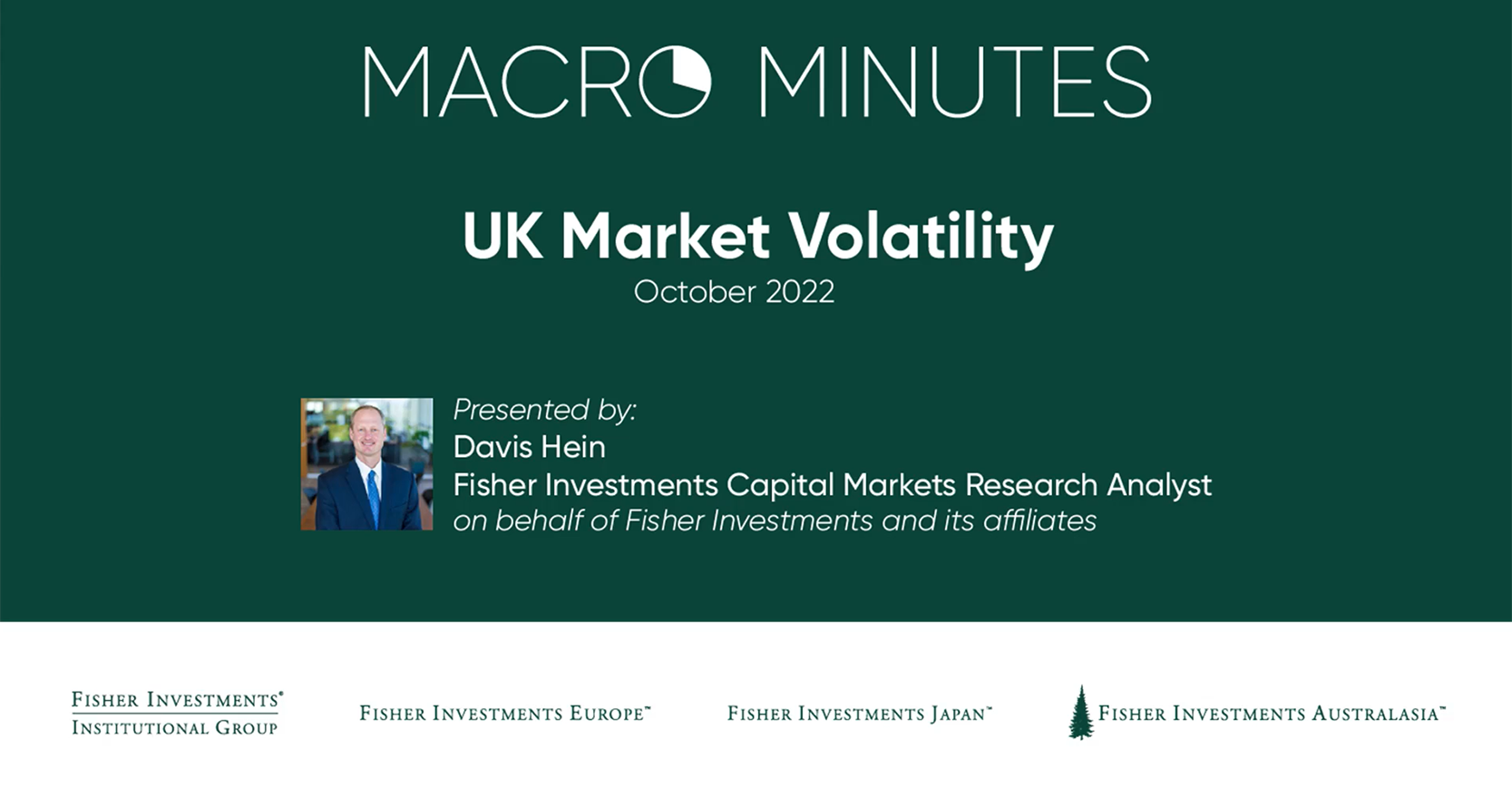Institutional Investing / Macro Insights
Macro Minutes: UK Market Volatility

In our latest Macro Minutes video, Fisher Investments’ Capital Markets Research Analyst Davis Hein offers a global perspective on the recent market volatility in the UK, taking a step back to look at how we got here and differentiate fear from fact as we look forward.
Key Points
- The UK faced significant headwinds as the year progressed and grappled with slowing economic growth and hotter inflation than developed nation peers, leading to increased market volatility and investor fear.
- UK yields rose significantly following the announcement of a new budget, while yield curves in the US and Europe reacted on a smaller scale indicating a lack of systemic disruption.
- Funding costs for the UK remain relatively low, significantly below the 40-year average, allowing the government to continue borrowing relatively cheaply and likely be able to pay its debts for the foreseeable future.
Transcript
|
Visual |
Audio |
|---|---|
|
Title screen appears, “Marco Minutes, UK Market Volatility October 2022. Presented by Davis Hein Fisher Investments Capital Markets Research Analyst on behalf of Fisher Investments and its affiliates |
|
|
A man appears on the screen wearing a grey suit sitting in an office. He begins to speak. |
Davis Hein: Hello, I'm Davis Heine and I'm a capital markets analyst here at Fisher Investments. The UK has been in the news lately as it's faced a political shakeup, rising energy costs. New Prime Minister Liz Truss, expansionary fiscal policy and the initiation of a bond buying program by the Bank of England in an effort to stabilize rates. While there are some legitimate macroeconomic concerns here, the extreme market volatility in UK equities and rates that we've seen over the past few weeks is perhaps an overreaction, as what we've called the pessimism of disbelief drives investors to discount benign news and search out for the negative, extrapolating current worries some legitimate and divisions of doom in the future. Today's presentation is designed to take a step back, look at how we've got here and try and differentiate fear from fact as we look forward at the UK's future. |
|
A graph appears on the screen with the title “2022 UK Political Timeline” |
Davis Hein: So where do we go from here? The UK faced significant headwinds as the year progressed, grappling with slowing economic growth and hotter inflation than developed nation peers. UK citizens were caught between falling real wages and sharply rising energy costs as an energy price cap reset scheduled for October, was expected to increase household heating costs by up to 80%. Voters were angry, placing increasing political pressure on former Prime minister Boris Johnson, who narrowly survived a no confidence vote in June but still resigned a month later as he lost the support of his cabinet, Conservative ministers of parliament and many British voters following a number of scandals, including party gate. Davis Hein: A number of British politicians then threw their hat into the ring for the vacated Prime Minister seat. But the race ultimately boiled down to Rishi Sunak and Liz Truss. Sunak campaigned on a platform of fighting inflation and fiscal restraint, whereas Truss focused on tax cuts, increased spending and greater ministerial oversight of the Bank of England. While the Ministers of Parliament preferred sunak's message of fiscal responsibility through the first five rounds, Truss won when the voting went to the citizens for the sixth and final round as Conservative Party constituents preferred Truss's populist tax cut promises. Once in office, Truss quickly followed through on many of her campaign promises, including announcing plans to cap energy prices for individuals and businesses on September 8th and proposing a new budget on September 23rd. Davis Hein: The budget largely consisted of a number of tax cuts without definition for how they'd be financed or input from the debt management office, which is the agency responsible for the debt and cash management of the UK government. And markets reacted with a touch of panic. UK stocks fell along with the pound while gilt yields spiked. Investors fretted over concerns of fiscal stability, fearing the tax cuts would drive UK government debt to unsustainable levels. Inflation concerns also rose as tax cuts could spur demand, forcing the Bank of England into a longer and higher than expected rate hiking cycle. Davis Hein: But upon closer examination, the tax cuts perhaps don't have the scale many investors feared, amounting to only about 1.4% of GDP. Additionally, the Trust administration has already backed away from parts of the proposal and moved forward. The Office of Budget Responsibility's assessment of the policy changes in an effort to calm market fears. Regardless, gilt yields rose rapidly, exacerbated by UK pensions, liquidating bonds to meet margin calls as interest rate swaps lost value. And the Bank of England stepped in on September 28, announcing a short term bond buying program to stabilize rates. So what does this all mean? The market reaction to the UK's new budget was swift and significant. Gilt yields spiked and the pound fell to multi-decade lows as investors worried about the government's fiscal credibility and tensions between the Bank of England and the trust administration. A heightened fear as Truss campaigned on increasing ministerial oversight of the bank and potentially changing its mandate. |
|
A new graph appears on the screen with the title, “Current Yield Curves – UK, US and EU. Following the budget announcement, UK yields rose considerably whereas yield curves in Europe and the US were largely un affected.” |
Davis Hein: We can see these fears reflected in yield curve changes since the announcement of the new budget. UK yields rose significantly following the announcement, with the largest move in the middle of the curve as markets priced in increasing midterm inflation on anticipated increases in consumption and demand. But yield curves in the US and Europe reacted on a smaller scale as broader bond markets were somewhat insulated from the UK concerns indicating a lack of systemic disruption. |
|
A new graph appears on the screen with the title, “UK Debt Remains Reasonable. Despite concern over the government’s fiscal credibility, the UK appears to be well-positioned to pay its debts over the foreseeable future. |
Davis Hein: Many investors fear the tax cuts and added spending on the energy price cap will force the UK to increase borrowing to an unsustainable level, fanning media speculation of a death spiral for UK finances, assuming the government won't be able to fund its obligations. In the future, these fears appear largely overblown. Even though the proposed tax reductions increased expectations for UK borrowing, the UK's debt scaled to its GDP is lower than many G7 peers. Funding costs for the UK remain relatively low, at around 4% on ten year gilts, significantly below the 40 year average of about 5.75%, allowing the government to continue borrowing relatively cheaply. And it appears that the UK is still well positioned to pay its debts over the foreseeable future. |
|
A new chart appears on the screen with the title, “Scaling the UK Economy. Although the UK is a key part of the global economy, its relative GDP may suggest that it doesn’t have the impact in global economic growth many assume.” |
Davis Hein: While the UK is a meaningful part of the global economy and structurally important in capital markets, it also doesn't have the impact on global economic growth that many assume. As it stands today, the UK is less than 4% of global GDP, meaning the global economy is likely resilient to any weakness in UK markets than investors fear. |
|
A new chart appear on the screen titled “UK Corporations Not Solely Dependent on Domestic Revenues. UK companies’ foreign revenues offset domestic weakness, falling pound may benefit earnings. |
Davis Hein: And from a portfolio management standpoint, when we think about the UK exposure, we need to differentiate the performance of UK stocks from the UK economy. The MSCI UK derives the majority of its revenues from international, not domestic sources, in contrast to countries like China and the US which derive the majority of their revenues domestically. This means UK shares are often less of a play on the UK economy and more positioned to benefit from the broad health of global consumption. While current effects may be temporary, lost in all of the fears of the falling pound is the observation that its decline could actually boost UK exporters’ profitability and competitiveness as foreign currency revenues are more valuable when brought home and converted into pounds. |
|
Davis Hein appears back on the screen. |
Davis Hein: Now, that's not to say there won't be downstream impacts from the rapid yield changes we've seen recently and increased expectations for Bank of England. Hiking Rumors of UK pension fund illiquidity surfaced recently as rising rates may have triggered margin calls on leveraged interest rate swaps. The funds purchased to support LDI strategies during the past decades. Low yield environment. Many funds may have been forced to sell gilts in order to meet those margin calls, creating a feedback loop that drove rates higher, still eventually forcing the Bank of England to step in and calm gilt markets with its bond buying program. Davis Hein: Additionally, rising mortgage rates may have downstream impacts on UK home affordability, consumer health and inflation expectations. Here at Fisher Investments, our research team is working hard to understand these downstream impacts, how they may create winners and losers and alter competitive balances. Contagion risks demand attention, but as it stands today, UK banks have some of the strongest capital ratios in their history, and we believe that they are well positioned to withstand disruptions like we've seen in the UK over the past few weeks. Davis Hein: From a macroeconomic perspective, the UK clearly has some headwinds, but the recent market reaction appears to be a massively sentiment driven event and both the UK economy and its markets are certainly stronger than recent market volatility would imply. Thank you for watching. If you would like to learn more about our views, please reach out to your relationship manager. |
|
A closing screen appears reading, “Thank you for watching! If you would like to learn more about our views, please reach out to your relationship manager or email fisherinstitutional@fi.com” Disclosures appear on the screen, “Investing in financial markets involves the risk of loss and there is no guarantee that all or any capital invested will be repaid. Past performance neither guarantees nor reliably indicates future performance. The value of investments and the income from them will fluctuate with world financial markets and international currency exchange rates. The information in this document constitutes the general views of Fisher Investments and its affiliates and should not be regarded as personalized investment advice or a reflection of the performance of Fisher Investments or its clients. We provide our general comments to you based on information we believe to be reliable. There can be no assurances that we will continue to hold this view, and we may change our views at any time based off new information, analysis or reconsideration. Some of the information we have produced for you may have been obtained from a third party source that is not affiliated with Fisher Investments. Fisher Investments requests that this information be used for your confidential and professional use. Data is month end long USD unless started otherwise.” |
See Our Institutional Insights
Stay on top of the latest investment trends and developments with our views and research.




